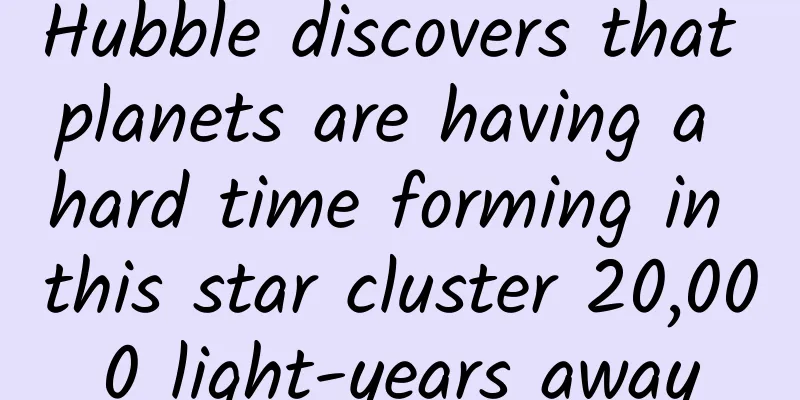Hubble discovers that planets are having a hard time forming in this star cluster 20,000 light-years away

|
Astronomers using the Hubble Space Telescope have discovered that planets are having a hard time forming in the chaotic central region of the massive and crowded Westerlund 2 star cluster. Located 20,000 light-years away, Westerlund 2 is a unique laboratory for studying stellar evolution processes because it is relatively nearby, fairly young, and contains a large number of stars. A three-year Hubble Space Telescope study of Westerlund 2 stars has revealed that protoplanetary disks surrounding stars near the cluster's center mysteriously lack large, dense dust clouds. Because these dust clouds could turn into planets millions of years later. However, observations show that stars in the outer reaches of the cluster do have giant planet-forming dust clouds embedded in protoplanetary disks. The researchers believe that our solar system followed this pattern when it formed 4.6 billion years ago. So why do some stars in the Westerlund 2 cluster have difficulty forming planets, while others do not? It seems that planet formation depends on location, with the most massive and brightest stars in the cluster concentrated in the core, which is confirmed by observations of other star-forming regions. The large cluster contains at least 30 extremely massive stars at its center, some with up to 80 times the mass of our sun. Their blazing ultraviolet radiation and hurricane-like winds of charged particles blow up protoplanetary disks around nearby, lower-mass stars and disperse giant dust clouds. "Basically, if you have monster stars, their energy will change the properties of nearby protoplanetary disks around less massive stars," explained Elena Sabbi, principal investigator of the Hubble study and the Space Telescope Science Institute in Baltimore. There may still have been a protoplanetary disk, but the star changed the composition of the dust in the disk so it was harder to create stable structures, and ultimately planets had trouble forming. The study thinks the dust either evaporated after a million years or changed so dramatically in composition and size that planets didn't form. The Hubble observations represent the first time astronomers have analyzed an extremely dense star cluster to study which environments are favorable for planet formation. However, scientists still debate whether massive stars are born at the center or migrate there. Westerlund 2 already has massive stars at its core, even though it is a relatively young, 2-million-year-old system. Using Hubble's Wide Field Camera 3, the researchers found that of the nearly 5,000 stars in Westerlund 2, with masses between 0.1 and 5 times the mass of the Sun, 1,500 of them showed fluctuations in their light as the stars accreted material from protoplanetary disks. Orbital material that accumulates within protoplanetary disks can temporarily block some of the starlight, causing brightness fluctuations. However, Hubble only detected this orbital material signature around stars outside the dense central region of the cluster. Hubble witnessed large dips in brightness lasting up to 10 to 20 days before about 5% of the stars returned to normal brightness, and these dips were not detected in stars within 4 light-years of the center. These fluctuations are likely caused by large clumps of dust passing in front of the star. These clumps would appear in a tilted disk, almost edge-on, as seen from Earth, and the researchers think they are planetary bodies or structures in the making. These could be the seeds that eventually form planets in evolved systems. These systems are not seen near very massive stars, and have only been seen in systems beyond the center. Thanks to Hubble, astronomers can now see how stars accumulate in environments similar to the early universe, where star clusters were dominated by monster stars. Until now, the best-known nearby stellar environment containing massive stars is the star-forming region in the Orion Nebula. However, Westerlund 2 is a richer target because it has a much larger population of stars. Hubble's observations of Westerlund 2 are giving astronomers a better understanding of how stars of different masses change over time, and how the powerful winds and radiation from supermassive stars affect nearby lower-mass stars and their protoplanetary disks. For example, we see that lower-mass stars like our Sun, when close to extremely massive stars in a cluster, still have protoplanetary disks and can still co-exist with matter as they grow. But their protoplanetary disk structure seems to be very different from disks around stars that formed in the quiet environment far from the core of the cluster, and this information is very important for building models of planet formation and stellar evolution. This cluster will be an excellent laboratory for follow-up observations with NASA's upcoming James Webb Space Telescope. The Hubble Space Telescope helped astronomers identify stars that may have planetary structures. With the Webb Space Telescope, researchers can study which protoplanetary disks around stars have not accreted material and which disks still have material that could potentially form planets. This information about 1,500 stars will allow astronomers to map out how star systems grow and evolve. The Webb Space Telescope can also study the chemical composition of protoplanetary disks at different stages of evolution, see how they change, and help astronomers determine what role the environment plays in their evolution. Bo Ke Yuan | Research/From: NASA Goddard Space Flight Center The study was published in the journal Astrophysics DOI: 10.3847/1538-4357/ab7372 BoKeYuan|Science, technology, research, popular science Follow [Bokeyuan] to see more beautiful cosmic science |
Recommend
Guilin SEO training: Keyword rankings are always not on the homepage, these SEO optimization skills need to be mastered
For webmasters, keyword ranking is our goal of on...
Promotional tactics for selling goods through live streaming!
Recently, Wang Leehom's live streaming lectur...
Activity Operation: How to design activity prizes that stimulate user desire?
All methods of gaining traffic are designed as ba...
Double Eleven pre-sales exceeded 20 billion: How did Li Jiaqi and Wei Ya create huge GMV?
On the first day of Double Eleven pre-sale, Li Ji...
Toyota shows its determination to develop electric vehicles with new personnel changes
According to foreign media reports recently, Toyo...
Case Analysis | What should we pay attention to when using the invitation registration mechanism for low-cost customer acquisition?
The invitation registration mechanism is a functi...
Private domain traffic: How to build a WeChat private domain closed loop?
“In 2019, the national population reached 1.4 bil...
@You who are afraid of sugar: Is there any kind of sugar that is good for the body? What kind of sugar is this?
Sugar is an essential nutrient in our lives, but ...
A guy got diabetes after drinking sugar-free drinks as water... He thought sugar-free means healthy, but he was really wrong!
There was a report not long ago that a young man ...
How to choose event promotion channels and quickly launch events?
New media operation, channel selection, and maxim...
Product advantages and ranking methods of 360 application marketing!
What are the product advantages of app promotion?...
What aspects should companies consider before developing an APP?
Nowadays, all enterprises are moving towards mobi...
In his battle against time, he changed physics
For JA Wheeler, explaining time is a race with hi...
Brand marketing and promotion techniques for the movie "Nezha"!
introduction A good brand story can establish bra...
How is the random algorithm of WeChat red envelopes implemented?
I saw a question on Zhihu: How is the random algo...









